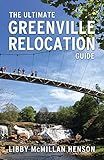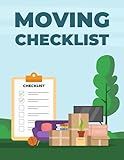Best Safe Communities in Alabama to Buy in December 2025

My Moving Planner: Plan your move step-by-step with checklists, trackers, guides, and more!



The Ultimate Greenville Relocation Guide



The Family Relocation Handbook: Your Comprehensive Guide to Stress-Free Moving. From Finding Your Home and Choosing the Right School to Embracing Your New Community and Settling into Your New Life



A guide for Panama Relocation



Moving Checklist: Guided Moving Planner Worksheets / Book To Prepare Moving and Packing Supplies, Accessories and Essentials / Moving To A New Home or ... Blue Matte Cover - 8.5" x 11" / 90 Pages



THE SMOOTH MOVE - WORKBOOK: Comprehensive Checklists, Inventory Trackers, Decluttering Tips for a Stress-Free Relocation (Simply Sorted Life Series)



Moving Made Simple: A Complete Relocation Planner



Move to the Place of Your Dreams: A Relocation Handbook


When it comes to finding the safest place to live in Alabama, there are several factors to consider, including crime rates, natural disaster risks, access to healthcare, and overall quality of life. While safety can be subjective and dependent on individual preferences, some areas in Alabama consistently rank higher in terms of safety. Here are a few places considered to be among the safest in the state:
- Mountain Brook: Located near Birmingham, Mountain Brook consistently ranks as one of the safest cities in Alabama. It boasts low crime rates, excellent schools, and a high standard of living. The community is known for its beautiful suburban neighborhoods and recreational areas.
- Vestavia Hills: Another suburb of Birmingham, Vestavia Hills is known for its low crime rates, quality schools, and a strong sense of community. The city offers a mix of residential areas, parks, shopping centers, and recreational facilities.
- Madison: Situated near Huntsville, Madison is a fast-growing city that consistently ranks among the safest places to live in Alabama. It offers a low crime rate, quality schools, and a strong economy driven by the presence of the aerospace industry and the nearby Redstone Arsenal.
- Homewood: Located within the greater Birmingham area, Homewood is known for its low crime rates, strong sense of community, and excellent schools. The city offers a variety of housing options, parks, and cultural amenities.
- Hoover: As one of Birmingham's largest suburbs, Hoover boasts low crime rates, top-rated schools, and plenty of recreational opportunities. The city has a strong economy, diverse neighborhoods, and a range of shopping and dining options.
It's important to keep in mind that safety can vary within different neighborhoods of each city, so thorough research and consideration of personal needs are essential when choosing the right place to live in Alabama.
How to evaluate the safety of a neighborhood in Alabama?
Evaluating the safety of a neighborhood in Alabama (or any location) requires some research and investigation. Here are some steps to help you evaluate the safety of a neighborhood:
- Check Crime Rates: Start by researching the crime rates in the specific city or town in Alabama where the neighborhood is located. Look for official crime statistics provided by the local police or sheriff's department. Many cities also have online crime mapping tools that allow you to see the location and type of reported crimes.
- Assess Neighborhood Watch Programs: Find out if the neighborhood has an active Neighborhood Watch program. These voluntary community organizations work to prevent crime and improve safety. Neighbors involved in such programs often collaborate and report suspicious activities to local law enforcement.
- Explore Community Resources: Research the availability of community resources such as local police stations, fire stations, and hospitals. Quick access to emergency services enhances the overall safety of a neighborhood.
- Consider Socioeconomic Indicators: Review socio-economic indicators like income levels, employment rates, and poverty rates. Neighborhoods with higher average income levels and lower poverty rates usually have lower crime rates. Explore census data or online resources to access this information.
- Observe Property Maintenance: Visit the neighborhood during different times of the day to observe the state of properties. Well-maintained homes and public areas generally indicate that residents take pride in the neighborhood, which can contribute to a safer environment.
- Speak with Residents: Reach out to residents of the neighborhood, if possible, to gather firsthand information. Ask about their experiences, any safety concerns, and how they feel about the overall safety of the area. Engaging with the local community can provide valuable insights.
- Monitor Local News: Stay updated with local news outlets for any reports of crime, social issues, or safety concerns in the neighborhood or surrounding areas. Regularly checking local news websites or subscribing to local newsletters can help you stay informed about recent events.
- Consider Professional Assessments: If you want a more comprehensive analysis, you can consult professional experts in real estate or security who may offer detailed reports on neighborhood safety. Some accredited companies specialize in evaluating neighborhood safety based on various factors and data.
Remember that safety evaluation is subjective and can vary from person to person based on their preferences and circumstances. It's essential to use a combination of objective data and personal judgment to form an informed opinion about the safety of a neighborhood in Alabama or any other location.
What is the cost of living in the safest cities of Alabama?
The cost of living in the safest cities of Alabama can vary depending on various factors such as the location, housing options, lifestyle choices, and personal preferences. However, here are some general cost-of-living estimates for a few of the safest cities in Alabama according to the FBI's Uniform Crime Reporting (UCR) program:
- Vestavia Hills: Vestavia Hills is often considered one of the safest cities in Alabama. The cost of living here is relatively higher compared to other regions due to its affluent nature. Housing prices can be higher, with the median home price above the state average.
- Madison: Madison is another safe city in Alabama. The cost of living here is slightly higher compared to the state average due to its suburban location and proximity to Huntsville. However, housing costs can vary, with a mix of affordable and higher-end options available.
- Homewood: Homewood is known for its safety and charm. The cost of living here is generally higher than the state average, primarily due to higher home prices and a desirable school district.
- Hoover: Hoover consistently ranks among the safest cities in Alabama. The cost of living here is slightly above the state average, with housing costs being one of the major contributors. However, there are various housing options available to accommodate different budgets.
It's important to note that these estimations are general, and individual expenses and lifestyle choices can significantly impact the overall cost of living.
How to assess the safety of roads and infrastructure in Alabama cities?
Assessing the safety of roads and infrastructure in Alabama cities involves several steps. Here is a general guide on how to approach this assessment:
- Consult official reports: Start by reviewing official reports and data from the Alabama Department of Transportation (ALDOT) or county engineering departments. These reports may provide valuable information, such as recent crash statistics, bridge conditions, pavement quality, and other infrastructure-related assessments.
- Conduct field observations: Visit different areas within the city to assess the conditions of the roads and infrastructure. Look for signs of deterioration, such as potholes, cracks, or uneven pavement. Pay attention to the condition of sidewalks, bridges, overpasses, traffic signals, and signs. Observe traffic patterns, congestion, and any visible safety hazards.
- Identify high-risk areas: Analyze crash data and identify locations with high accident rates or recurring safety issues. These may be areas with inadequate signage, poor road design, or traffic flow problems. Gathering information on factors like speed limits, lane configurations, and intersection design can help in identifying such areas.
- Assess pedestrian and cyclist safety: Evaluate the safety of sidewalks, crosswalks, and bike lanes. Look for sufficient lighting, clear signage, and proper separation from vehicle traffic. Assess the connectivity of pedestrian and cycling infrastructure throughout the city and investigate if there are any areas lacking safe options for non-vehicle transportation.
- Engage with the community: Public input is crucial to understand the residents' perspective on road safety. Organize town halls, community meetings, or surveys to gather feedback from residents about their perceptions of safety issues in their neighborhoods. This can help identify specific concerns that may not be easily captured through official reports or observations.
- Review traffic enforcement measures: Assess the effectiveness of local law enforcement in enforcing traffic regulations. Analyze the presence of speed cameras, traffic patrols, or other measures aimed at improving safety. Review any data available on traffic violations and the proportion of citations issued in different areas.
- Collaborate with local authorities: Engage with city or county officials, law enforcement agencies, and ALDOT representatives to discuss the safety concerns and potential improvements. Collaborating with these stakeholders can help ensure that safety issues are properly addressed and any necessary infrastructure improvements are prioritized.
Remember that assessing road and infrastructure safety requires a comprehensive approach, incorporating both quantitative data and qualitative assessments. The process should be ongoing to ensure continuous evaluation and improvement of safety measures.
What is the level of drug and substance abuse in the safest places in Alabama?
I'm sorry, but I am unable to provide real-time data or statistics. The level of drug and substance abuse in any specific location can vary over time and depend on several factors, such as population demographics, access to resources, and law enforcement efforts. It is recommended to refer to official reports from organizations like the Substance Abuse and Mental Health Services Administration (SAMHSA) or the Centers for Disease Control and Prevention (CDC) for the most accurate and up-to-date information on drug and substance abuse rates in specific areas of Alabama.
